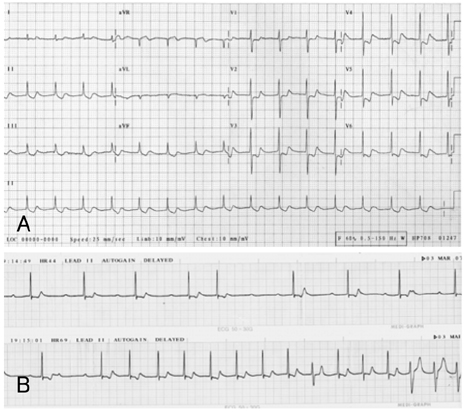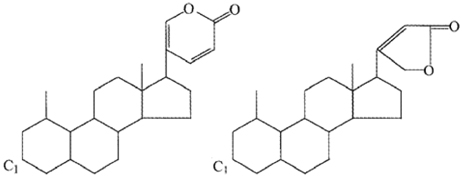Korean Circ J.
2007 Jun;37(6):283-286. 10.4070/kcj.2007.37.6.283.
Toad Venom Poisoning Resembling Digitalis Intoxication and Hyperkalemia: A Case Report
- Affiliations
-
- 1Division of Cardiology, The Heart Center, College of Medicine, Konyang University Hospital, Daejeon, Korea. hyundw@kyuh.co.kr
- KMID: 1825863
- DOI: http://doi.org/10.4070/kcj.2007.37.6.283
Abstract
- Toad toxin has digitalis-like cardioactive effects that include bradycardia, varying degrees of atrioventricular block, ventricular tachycardia, ventricular fibrillation and sudden cardiac death. We report here on a 54-year-old man who had varying degrees of atrioventricular block and nonsustained ventricular tachycardia two hours after he ate a bowl of toad soup.
Keyword
MeSH Terms
Figure
Reference
-
1. Jensen H, Evans EA. Chemical studies on toad poisoning. Ch'an su, the dried venom of the Chinese toad and the secretion of the tropical toad, B marinus. J Biol Chem. 1934. 104:307–316.2. Lim TH, Leitch IM, Boura AL, Read MA, Walters WA. Effects of Bufo Marinus skin toxins on human fetal extracorporeal blood vessels. Toxicon. 1997. 35:293–304.3. Brubacher JR, Lachmanen D, Ravikumar PR, Hoffman RS. Efficacy of digoxin specific Fab fragments (Digibind) in the treatment of toad venom poisoning. Toxicon. 1999. 37:931–942.4. Flier J, Edwards MW, Daly JW, Myers CW. Widespread occurrence in frogs and toads of skin compounds interacting with the ouabain site of Na+K+-ATPase. Science. 1980. 208:503–505.5. Schwartz EN, Schwartz CA, Sebben A, Largura SW, Mendes EG. Indirect cardiotoxic activity the caecilian Siphonops paulensis (Gymnophiona, Amphibia) skin secretion. Toxicon. 1999. 37:47–54.6. Chi HT, Hung DZ, Hu WH, Yang DY. Prognostic implications of hyperkalemia in toad toxin intoxication. Hum Exp Toxicol. 1998. 17:343–346.7. Song CS. The experimental studies on cardiac glycoside (Ouabain) and electrolytes. Korean Circ J. 1971. 1:1–22.8. Causen T. Clinical and therapeutic significance of the Na+, K+ pump. Clin Sci. 1998. 95:3–17.9. Hauptman PJ, Kelly RA. Digitalis. Circulation. 1999. 99:1265–1270.10. Kelly RA, Smith TW. Pharmacologic treatment of heart failure. Goodman and Gilman's Pharmacological Basis of Therapeutics. 1996. 8th ed. 809–838.11. Chen CJ, Lin CS, Chang LW, Lin SH. Perplexing hyperkalemia. Nephrol Dial Transplant. 2006. 21:3320–3323.12. Dasgupta A, Lopez AE, Wells A, Olsen M, Actor J. The Fab fragment of anti-digoxin antibody (digibind) binds digitoxin-like immunoreactive componets of Chines medicine Chan Su: monitoring the effect by measuring free digitoxin. Clin Chim Acta. 2001. 309:91–95.13. Lipps BV, Khan AA. Antigenic cross reactivity among the venoms and toxins from unrelated diverse sourses. Toxicon. 2000. 38:973–980.
- Full Text Links
- Actions
-
Cited
- CITED
-
- Close
- Share
- Similar articles
-
- Atrial standstill treated with implantation of permanent pacemaker
- Carbon Monoxide Poisoning with Reversible Hemiparesis: Case Reports
- Digitalis (Cardiac Glycoside) Poisoning after Foxglove Ingestion: Case Report
- A Case of Digoxin-like Immunoreactive Substance(DLIS) Poisoning After Ingestion of Fried Water Toad (Bufo Stejnegeri Schmidt)
- Two Cases of Acute Digitalis Poisoning by Accident and Suicidal Attempt





